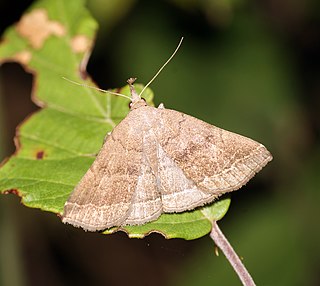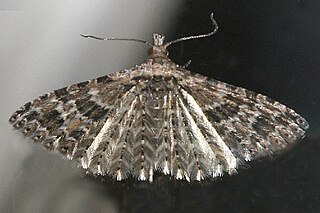
The currant pug is a moth of the family Geometridae. The species was first described by Henry Doubleday in 1856. It is found across the Nearctic and Palearctic regions .Its occurrence extends eastwards to the Near East, Urals, the Ussuri region and on to the island of Sakhalin. In the Pyrenees and the Alps it rises to altitudes of 1500 and 1800 metres respectively.

The common pug(Eupithecia vulgata) is a moth of the family Geometridae. It is a common species across the Palearctic region, including the Near East and North Africa. It ranges from the Atlantic coast of Ireland and Portugal across Europe, the Middle East and Central Asia to the Russian Far East (Priamurje) and Korea.

The goldenrod pug is a moth of the family Geometridae. The species was first described by Henry Doubleday in 1861. It is found throughout the Palearctic region. In the British Isles it is widespread but rather locally distributed.

The mottled beauty is a moth of the family Geometridae. The species was first described by Carl Linnaeus in his 1758 10th edition of Systema Naturae.

Vagrans is monotypic genus with the species vagrant a species of nymphalid butterfly found in forested areas of tropical South Asia and Southeast Asia.

Lomographa temerata, the clouded silver, is a moth of the family Geometridae. The species was first described by Michael Denis and Ignaz Schiffermüller in 1775.

Macaria notata, the peacock moth, is a moth of the family Geometridae. It is a Holarctic species.

Theria primaria, the early moth, is a moth of the family Geometridae. It is found throughout Western Europe and the South Caucasus.

Macaria wauaria, the V-moth, is a moth of the family Geometridae. It has a Holarctic distribution. The species was first described by Carl Linnaeus in his 1758 10th edition of Systema Naturae.

Macaria is a genus of moths in the family Geometridae raised by John Curtis in 1826. It is sometimes placed as a synonym of Semiothisa. Species are cosmopolitan.

Polypogon plumigeralis, the plumed fan-foot, is a species of litter moth of the family Erebidae found in Africa, Asia and Europe. It was first described by the German entomologist Jacob Hübner in 1825.

Mesotype didymata, the twin-spot carpet, is a moth of the family Geometridae. The species was first described by Carl Linnaeus in his 1758 10th edition of Systema Naturae. Its genus is sometimes included in Perizoma.

Anavitrinella pampinaria, the common gray, is a moth of the family Geometridae. The species was first described by Achille Guenée in 1857. It is found in most of North America except the Arctic regions, south to Mexico.

Alucita montana, the Montana six-plume moth, is a moth of the family Alucitidae. It was described by William Barnes and Arthur Ward Lindsey in 1921. It is found in North America from south-western Quebec and Vermont, west to British Columbia and south to Arizona, California and Texas.

Ethmia dianemillerae is a moth in the family Depressariidae. It is found in Costa Rica, where it has been recorded at middle elevations on the Caribbean slope of Cordillera Volcánica de Guanacaste, Cordillera Volcánica Central and in the lowlands of the northern Caribbean. The habitat consists of rain forests.
Ambia cymophoralis is a moth in the family Crambidae described by George Hampson in 1917. It is found on St Aignan Island in the Louisiade Archipelago of Papua New Guinea.
Ambia fulvicolor is a moth in the family Crambidae. It was described by George Hampson in 1917 and it is found in New Guinea.
Ambia melanistis is a moth in the family Crambidae. It was described by George Hampson in 1917 and it is found in Taiwan.
Anacampsis scalata is a moth of the family Gelechiidae. It was described by Edward Meyrick in 1914. It is found in Guyana and Brazil (Para).

Asaphodes glaciata is a species of moth in the family Geometridae. This species is endemic to New Zealand. This moth has only be found in Westland in the areas near Fox and Franz Josef Glaciers.















